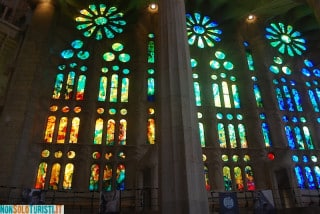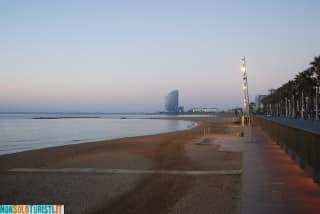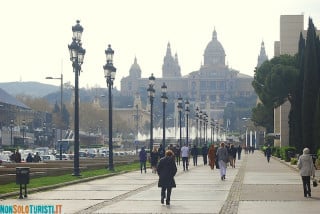Finally I arrived in Barcelona. I can’t say why I never visited this town before: I have always admired Gaudì’s work, but at the same time I figured out the Catalan capital as a cove of drunk kids, showing off their stylish haircuts and their expensive clothes.
Still, here I am, in the heart of the movida. Well, I didn’t really get into the movida at all: I walked through the popular Rambla just once, late in the night, while everything was closed, and my headquarter is a charming little flat in the Gothic Quarter. Here ancient buildings and medieval fortresses are crossed by small alleys hosting cellar-sized restaurants and bar crowded by any kind of colourful youth.
Over my room I can hear tip tap students exercising every day, while below there is a cultural circle hosting folk bands and singers. Not exactly the quietest place, but I admit I feel perfectly at home in this charming chaos. And when I discovered a piano in the Cat Bar, just in front of my flat, where musicians just leave a cup for the tips on the top of it and play as they like, I was overwhelmed by the Gothic Quarter’s melancholy and finally saw in Barcelona a more complex town, a destination for dreamers and introverted travellers, for lost souls and generous artists.
Beside roaming in the Gothic Quarter, my goals in Barcelona have always been simple and clear: Sagrada Familia, Pedrera and paella. I tasted the latter in several restaurants, it’s always good but never extraordinary. After all, I had been alerted that Barcelona isn’t a food destination: you can eat quite well, but that’s all you can hope for.
The Sagrada Familia raised contrasting emotions in me. Antoni Gaudì‘s obsession is a stunning colossal monument, a hymn to arts’ grandiosity and to his own genius, to his research inspired by nature and movement. I can almost hear him boasting among the huge rooms, among the tremendous vertical lines reflecting the colourful rays filtered by the windows. I can see him stopping in front of the Holy Cross in mid-air – a surreal vision more fit for a post-modern gallery than for directing prayers – and simile towards the stunned visitors: ‘This is all my work… and you, what have you done in your life?’
The religious aim of the place is long gone, and one can perceive it starting from the 19 euros asked as entrance fee – including the visit to the towers – and have confirmation once arriving in the souvenir shop. This didn’t stop the curators from hanging severe signs asking for silence because it’s ‘a place for worship and prayer’.
I don’t believe worship and prayer mattered much to Gaundì, to him the only important thing was his masterwork. And when he got his hands on other buildings he didn’t miss the chance to direct an arc, a line or a window towards his beloved Familia. He put such a hint also on the Pedrera‘s rooftop, to remember to the Milà family – who were paying him profusely for their new residence – which was the only creation he really cared for.
Poor Milàs ended up with a house looking absolutely ridiculous at that time, since on Passeig de Gracia there weren’t yet all those impressing architectures which are nothing than homages to Gaudì’s genius. After all, Barcelona’s people nicknamed it pedrera, ‘rock cave’.
Still unsatisfied, old Antoni added piece a-fter piece to realize a unique construction, raising the final price for the owners who one fine day decided to fire him and, instead of completing the roof, embellished with cava mosaics – made with fragments of the delicious sparkling wine’s bottles – only those parts showing towards the street.
This is the Barcelona I love: few parties, much art, many stories. And if someone would care to tell me where I could find a great paella…





















Like you I can’t figure out why I have never been to Barcelona. When I leave Asia next year revisiting Spain and getting to know Barcelona is top of my list. You photos are inspiring!